|
Put the Pedal to the
Metal
by Bob Brooke
Most people equate the pedal car with
childhood and the age of innocence, recalling the times zooming
around the backyard and selling lemonade at the end of the driveway.
The pedal car was one of those toys American kids would get only at
Christmas, if they got one at all.
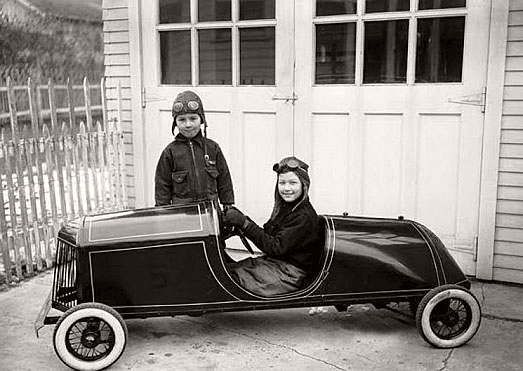
How It All Began
Pedal cars have been around almost as long as real cars. In the same way
as the motorcar was derived from the carriage, the pedal-car had its
origins in the tricycle. Iron tricycles, which already existed at the
end of the 19th century, were the starting point for kids’ cars; dressed
up with a simple body and fitted out with an extra wheel.
The first known commercially produced pedal car, built in a cabinet shop
in the eastern U.S., has a patent date in the early 1890's. However, the
names of the first pedal-car producers remain obscure. Often it was the
bicycle manufacturers who put these avant-garde toys onto the market.
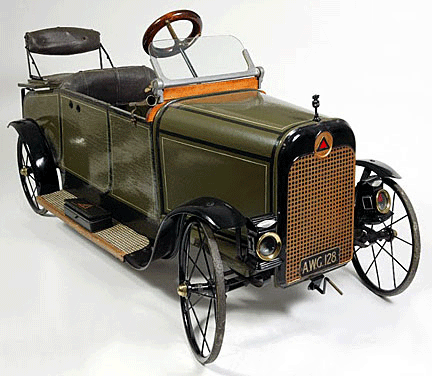 The
first pedal cars were expensive hand-built toys for the rich, detailed
and finished to superb quality with all the lights, handles and trim
found on a real car. But around 1910, the pedal-car started to gain
popularity. Cars for kids now tried to imitate grown-up cars in every
way, and manufacturers offered pedal cars resembling the real cars of
the era–Buick, Cadillac, Packard, Pierce Arrow, Pope and Winton–with
every type of accessory, including sloping windshields, mudguards,
licence plates, lights, nickel-plated parts, bumpers, spare wheels,
tires, horns, and padded seats. Pedal car makers replaced wood with
metal and color and decorations brightened up the models. The
first pedal cars were expensive hand-built toys for the rich, detailed
and finished to superb quality with all the lights, handles and trim
found on a real car. But around 1910, the pedal-car started to gain
popularity. Cars for kids now tried to imitate grown-up cars in every
way, and manufacturers offered pedal cars resembling the real cars of
the era–Buick, Cadillac, Packard, Pierce Arrow, Pope and Winton–with
every type of accessory, including sloping windshields, mudguards,
licence plates, lights, nickel-plated parts, bumpers, spare wheels,
tires, horns, and padded seats. Pedal car makers replaced wood with
metal and color and decorations brightened up the models.
The first pedal cars had a metal chassis,
a wooden body and wheels with spokes, sometimes with rubber covered
rims. Young drivers operated their cars by pedals and block chain, but
gradually manufacturers produced more with a mechanism operated on a
system of levers, in which movement was transmitted from the pedals to
the back wheels, just like on a real car. "Smooth wheels with roller
bearings, cantilever springs, and balloon tires helped propel some pedal
cars with greater ease," said Andrew G. Gurka, author of the book Pedal
Car Restoration and Price Guide. "Most cars had a windshield, and some
models featured working windshield wipers.”
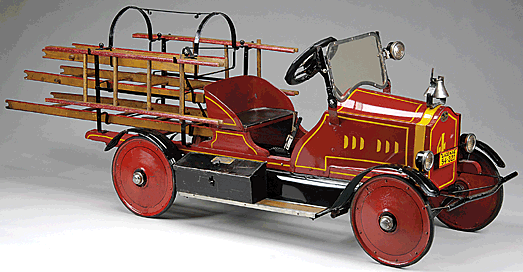
Over the years, manufacturers built pedal
cars to reflect the automotive styling of the day. Cars from the late
Teens and Twenties had the "Tin Lizzie" look of flat fenders and
free-standing headlamps. The 1930's brought Art Deco "Airflow" styling
with curving grilles and covered rear wheels. Forties styling was more
"streamlined" with aircraft overtones and less trim.
The U.S. led the world in pedal-car production preceding World War I.
Not only did pedal cars appear of every type and for every budget, but
so did trucks, fire-engines, police cars, and vans with small work
accessories and even a car with its own little garage.
Pedal Cars After World War I
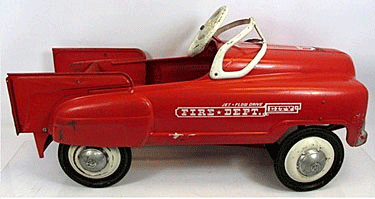 After
the war, the car business got back into full swing. During the 1920's,
pedal car manufacturers offered many kinds of roadsters. Large fenders
came into vogue, as did polished radiators and radiator ornaments. The
pointed tail premiered as the chief characteristic of model racing cars.
But a new element helped give a final touch of realism to pedal
cars--electricity. In the few cases of early model cars which boasted
lights, they were simply fake ones, except for a few very sophisticated
models which were provided with small oil lamps. In 1922, pedal cars
with electric lights running on batteries became a reality. Though they
didn’t serve much purpose, these lights gave young drivers a feeling of
importance. The whole experience of driving became more “real.” After
the war, the car business got back into full swing. During the 1920's,
pedal car manufacturers offered many kinds of roadsters. Large fenders
came into vogue, as did polished radiators and radiator ornaments. The
pointed tail premiered as the chief characteristic of model racing cars.
But a new element helped give a final touch of realism to pedal
cars--electricity. In the few cases of early model cars which boasted
lights, they were simply fake ones, except for a few very sophisticated
models which were provided with small oil lamps. In 1922, pedal cars
with electric lights running on batteries became a reality. Though they
didn’t serve much purpose, these lights gave young drivers a feeling of
importance. The whole experience of driving became more “real.”
It was a logical step to extend the use of electricity to the traction,
too, as makers created the first cars for children with electric motors.
Fortunately, they cost too much, thus guaranteeing the survival of the
pedal car.
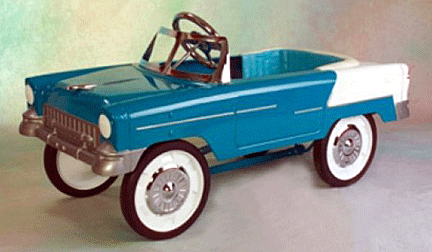 In
the U.S, pedal car makers freely used the names of the big car
manufacturers, while their European counterparts often did not. In 1925,
for example, the American National Company produced an enclosed Packard
coupe for children. Boycraft produced a spider with the name Cadillac on
it, while a Steelcraft catalog of the same year offered Buicks, Nashs,
Studebakers, Lincolns, Pierce Arrows, Marmons, Chryslers and even Macks,
given that it wasn’t rare for catalogs to include trucks for kids.
Whether there was a real car used as a model in each of these cases is a
point yet to be proven. However, the names were there and served to
attract the young public. Americans called these cars “Juvenile
Automobiles” or “Wheel Goods Toys,” a term that included any type of
vehicle for children operated by pedals. In
the U.S, pedal car makers freely used the names of the big car
manufacturers, while their European counterparts often did not. In 1925,
for example, the American National Company produced an enclosed Packard
coupe for children. Boycraft produced a spider with the name Cadillac on
it, while a Steelcraft catalog of the same year offered Buicks, Nashs,
Studebakers, Lincolns, Pierce Arrows, Marmons, Chryslers and even Macks,
given that it wasn’t rare for catalogs to include trucks for kids.
Whether there was a real car used as a model in each of these cases is a
point yet to be proven. However, the names were there and served to
attract the young public. Americans called these cars “Juvenile
Automobiles” or “Wheel Goods Toys,” a term that included any type of
vehicle for children operated by pedals.
Pedal cars became increasingly more tempting at the onset of the 1930's,
considered as the golden age of pedal cars, and apparently not having
been affected by the Great Depression. The models of the 1930's were
larger and heavier than in any other period in history. Streamlining
began to take hold with American, National, Gendron, and Steelcraft
offering new designs. Makers featured artillery wheels with large plated
hubcaps, as well as hood ornaments resembling graceful works of art. In
1938, Troy of Philadelphia offered a series of cars with the
characteristic wind-divider “nose,” which marked a whole period around
the war.
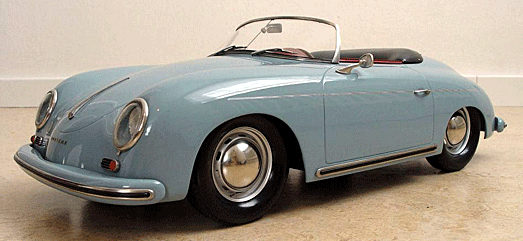
In the 1940's pedal car manufacturers offered their versions of military
vehicles. Before World War II, the pedal car was for rich kids. After
the war, they became more common but were still more extravagant than a
hand-me-down bicycle or wagon.
Post World War II Pedal Cars
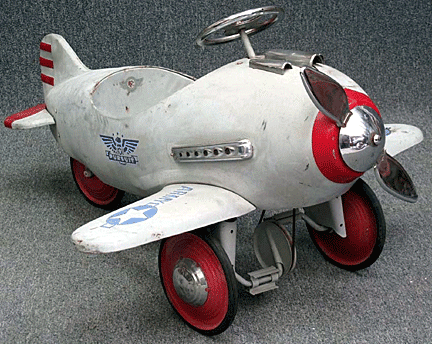 The
1950's found designers trying to create fantasy cars that had jet plane
and spaceship themes. The hot rod also became popular during this era.
Pedal cars during the 1960's emerged with decals and plastic trim and
some could be ordered with a metallic finish. Garton, Murray and the
American Machine and Foundry Company (AMF) all had a large array of
products for consumers to choose from. The
1950's found designers trying to create fantasy cars that had jet plane
and spaceship themes. The hot rod also became popular during this era.
Pedal cars during the 1960's emerged with decals and plastic trim and
some could be ordered with a metallic finish. Garton, Murray and the
American Machine and Foundry Company (AMF) all had a large array of
products for consumers to choose from.
AMF introduced the first "Midget Mustang" pedal car in November ,1964,
when the real Mustang was selling like crazy. The all-metal, bright red
toy retailed for $12.95, about half of what a similar pedal car sold for
at the time. Each car, equipped with wheel covers, a windshield, a
"3-speed" shift lever, oversized steering wheel, a "Rally Pak" cluster
of gauges, white upholstery and black rubber tires, had a pony emblem in
the center of the grille and the Mustang name in script with a rocker
panel stripe on the sides.
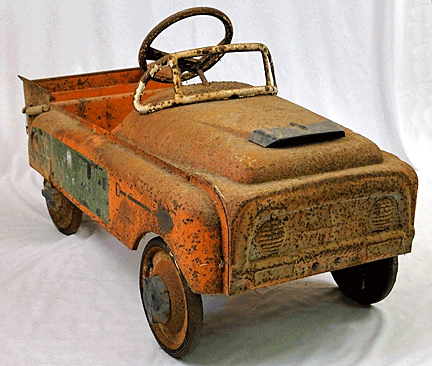 By
the 1970's pedal cars were becoming a dusty memory in the corner of the
garage as the bicycle craze had begun. Of the product lines that
remained, most manufacturers had switched to thinner gauge metal and
plastic pedals. The "Big Wheel" by Mattel lowered the center of gravity
on the original tricycle design, combined with light weight and low cost
plastic construction. They were so inexpensive that they could be
replaced when they wore out or broke. By
the 1970's pedal cars were becoming a dusty memory in the corner of the
garage as the bicycle craze had begun. Of the product lines that
remained, most manufacturers had switched to thinner gauge metal and
plastic pedals. The "Big Wheel" by Mattel lowered the center of gravity
on the original tricycle design, combined with light weight and low cost
plastic construction. They were so inexpensive that they could be
replaced when they wore out or broke.
Styling changed often during the 1950's, following Detroit’s lead. First
models had bold heavy grilles and tall narrow fins, but makers soon
replaced these with wider, square fronted bodies with dual headlamps and
angle-swept fins. By 1960, pedal cars had become more rounded and
started to resemble popular sports cars.
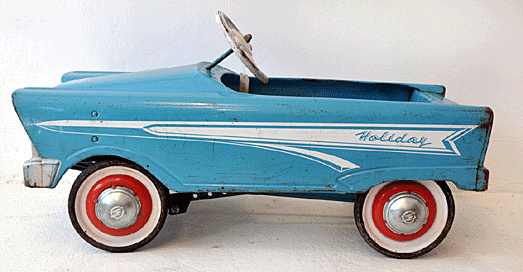
The use of plastic meant lower prices and contributed to the popularity
of pedal cars but was also responsible for poorer quality. The new model
cars had little in common with their ancestors of the 1920's and 1930's,
which were notable for their craftsmanship.
According to Don Sindelar, a pedal car dealer from Saugus, California,
pedal car manufacturers marked their models with both a name and a model
number--a firetruck may be a AMF 508 or a locomotive a Casey Jones.
Antique toy collectors were the first to "discover" pedal cars. Starting
in the early 1960's, collectors began acquiring mint condition examples
found in attics. Later on, "baby boomers" bought either new or
reproduction pedal cars for their kids.
“The most collectable models are the 1930s Steelcraft cars—Lincoln
Zephyr, 1938 Oldsmobile, 1936 Ford, 1941 Buick, 1941 Chrysler,” said
John Dott, pedal car restorer and collector. “Foreign models aren’t very
popular here in the U.S. Americans collect mostly U.S.- made cars.”
<
Back to More Antique Spotlights
Next Article > |
